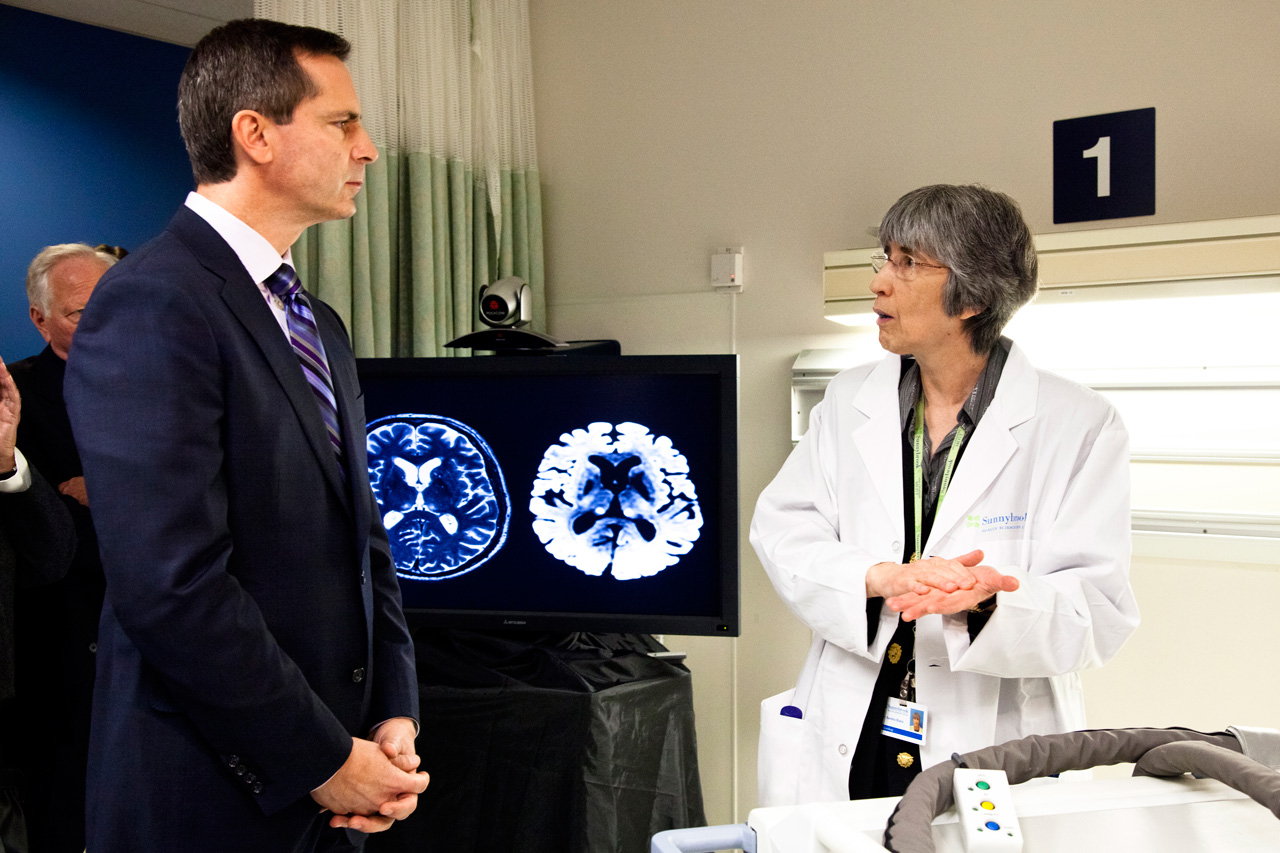Brain scientists give Premier a glimpse into the future
No crystal ball was needed to give Ontario Premier Dalton McGuinty and Minister of Research and Innovation Glen Murray a look into the future of treatment for brain disorders. Instead, brain scientists gave the politicians an exclusive tour of the S ground imaging research facility at Sunnybrook Research Institute (SRI). The premier and minister were shown how magnetic resonance (MR)-guided focused ultrasound works during a visit to Sunnybrook to announce the Ontario Brain Institute on November 15.
"Showing Premier McGuinty and Minister Murray that we are at the forefront of brain sciences innovation not only in Ontario, but indeed in all the world, was an honour," said Dr. Michael Julius, vice-president, research, Sunnybrook Health Sciences Centre. "This work has led to breakthroughs on which a whole new science is being built. It's important we showcase our leadership in this arena."
Focused ultrasound is a method of applying energy to tissue located deep inside the body to effect a therapeutic result. When paired with MR, it enables precise targeting of the area of interest, helps guide the treatment as it is being performed, and verifies that the treatment worked (or did not work). Magnetic resonance-guided focused ultrasound has many potential applications; some of the most encouraging are in the brain.
Dr. Kullervo Hynynen, director of imaging research at SRI, invented the focused ultrasound device for the brain, which was subsequently commercialized by Israeli company InSightec. Hynynen was unable to host the tour, owing to an out-of-country commitment. In his stead, Drs. Bojana Stefanovic, Sandra Black and Todd Mainprize anchored the event.
Stefanovic, an imaging scientist at SRI, explained the physics behind the device to the premier and minister. She described how the device's multiple arrays solve the problem of skull beam distortion and enable the ultrasound to be focused precisely where desired. As the premier looked at the helmet-shaped device, she noted this innovation solves a longstanding problem of how to get into the brain without opening the cranium.
Black, director of the Brain Sciences Research Program, spoke to the device's therapeutic potential for stroke and dementia. She noted how in stroke it shows great promise to dissolve blood clots and restore blood flow in minutes in patients who are having a stroke. She also explained how researchers at SRI are using focused ultrasound paired with microbubbles to disrupt the blood-brain barrier and then deliver drug or gene therapy to localized brain regions to stop the progression of Alzheimer's disease.
Mainprize, a neurosurgeon at Sunnybrook, capped the tour by showing MR-guided focused ultrasound in action, using a phantom. He explained how the feedback that MR provides during a procedure enables physicians to make adjustments during the procedure, and confirms that the treatment is working. Mainprize then revealed that a clinical trial to test MR-guided focused ultrasound to treat essential tremors, the most common movement disorder, is set to begin in early 2011, followed later in the year by a trial for brain tumours.
"We are extremely optimistic about this novel technology and all of the potential applications to better the lives of patients in Ontario," said Mainprize.
After thanking the researchers for the tour, McGuinty and Murray were whisked away to the McLaughlin auditorium, where the premier announced $15 million in funding over three years to establish the Ontario Brain Institute. This virtual organization will bring together leading scientists in brain research from across the province.
The imaging research suite on S ground is part of SRI's Centre for Research in Image-Guided Therapeutics (CeRIGT), a $160-million centre that is scheduled for completion in 2011. The imaging suite has two InSightec systems for clinical testing, one for high-frequency brain work; the other for low-frequency brain work. Sunnybrook Research Institute is the only place in the world that has two systems.
To read more about CeRIGT, visit: sunnybrook.ca/research, and click on the CeRIGT image in the upper right-hand corner.



